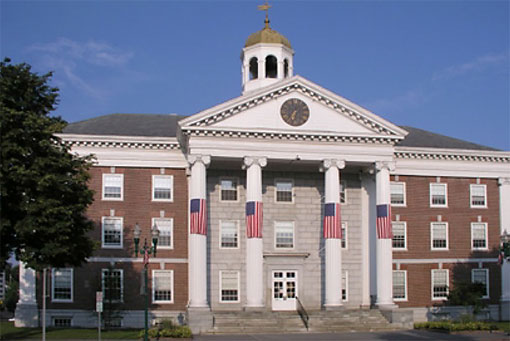| 제목 | [DAIKIN] GOVERNMENT - Auburn Memorial City Hall | 작성일 | 16-06-16 14:33 |
| 글쓴이 | 최고관리자 | 조회수 | 5,435 |
본문
Auburn, New York, can boast of a Colonial Revival beauty on the National Register of Historic Places. Designed in 1930 by the Boston architectural firm Coolidge, Shepley, Bulfinch & Abbott
CASE STUDY
Government
Name
Auburn New York Memorial City Hall
Location
Auburn, NY USA
Facility
Colonial Revival on the National Register of Historic Places, designed in 1930s
Issue
No air conditioning in the building
Solution
Water source heat pump geoexchange
heating and cooling system
Auburn preserves city hall, improves employee comfort with innovative
geoexchange system
When it comes to attractive city halls, Auburn, New York, can boast of a Colonial Revival beauty on the National Register of Historic Places. Designed in 1930 by the Boston architectural firm Coolidge, Shepley, Bulfinch & Abbott, the building features a masonry exterior over a steel frame, a columned porch, pediments, pilasters and other fine details. Inside, the high ceilings, stenciling, wood paneling, marble accents and ornate City Council chamber modeled on an old Boston courtroom create an aura of civic order that officials wanted to preserve.
The building also featured a wheezy steam boiler and gusty window and ceiling fans that just seemed to blow hot air (and papers) around faster. City Manager John Salomone was surprised to learn there was no air conditioning in the building when he arrived a few years ago. Employees sweltered through hot summers, with temperatures topping 95 degrees in some offices. No one wanted to preserve the current heating and cooling system.
Taking an innovative approach, city hall considered its alternatives and elected to install a geoexchange heating and cooling system for its efficiency and flexibility. Designed by Beardsley Design Associates Architechture, Engineering and Landscape Architechture, P.C., the system could be compatible with the building’s 70-year-old stateliness. As a result of design studies and careful retrofit, water source heat pumps from Daikin – now installed in city offices, meeting rooms and hallways – deliver comfortable, conditioned air while preserving and even enhancing the building’s architectural integrity.
City Hall’s new heating and cooling system had to meet several criteria. It had to be cost-effective, energy efficient, provide a more comfortable working environment, and blend into the landmark building both inside and out. While a gas boiler and central air system was a conventional choice, design engineer John Manning, P.E., recommended that the city consider an alternative that might even exceed expectations.
The geoexchange alternative
Almost without rival for energy efficiency, geoexchange systems reach down into the earth for a natural energy source rather than expending energy with a chiller, cooling tower or boiler. They are ideal for heating and cooling individual spaces, or zones, such as offices and classrooms that require independent heating and cooling.
A geoexchange system reduces energy costs because it draws from the constant temperature of the earth below the frost line-from 40 to 60 degrees Fahrenheit-for zoned cooling and heating. This approach significantly reduces demand on fossil fuels compared to other HVAC systems. The earth absorbs and stores up to 47 percent of the sun’s energy, according to the Environmental Protection Agency, providing a natural source for delivering constant temperature control above ground. Geoexchange systems can reduce energy consumption-and corresponding emissions such as carbon dioxide-by over 40 percent compared to conventional systems.
During the winter, water is pumped through underground pipes into the building, where the heat pumps pull heat from the water and distribute warm air to individual rooms or zones, such as a corridor or group of offices. In the summer, the process is reversed, with heated water transferred out of the building into the underground pipes, where it is cooled by the earth. In transitional seasons, heat may be sent to some parts of the building, while other areas require cooling at the same time.
Geoexchange systems include three main components: an earth connection (such as polyethylene piping) to transfer heat between the water in the pipe and the earth; one or two circulating pumps to move water into and out of the building; and water source heat pumps in each zone area to deliver the required heating and cooling. Both of these components are sized and optimized to significantly reduce energy consumption.
Research seals the deal
Such a system sounded good in theory, but City Hall required more proof that it would meet their requirements. Manning, who heads his own firm, Earth SensitiveSolutions, LLC, and Mike Long, grants manager for capital improvement projects for the city, developed a feasibility study of both conventional heating systems and geothermal technology. Their study earned a grant from New York State’s Energy and Research Development Authority (NYSERDA).
The results of the study, presented to the City Council and City Manager, included a comparison of installed cost, operating and maintenance cost, emissions and aesthetics:
Installed Costs: The estimated capital costs for each kind of system were about the same for initial installation-just under $1 million, with the geothermal system costing slightly more. The components of the two kinds of systems are listed in Table 1.
Table 1: Comparison of components

Operating and maintenance costs:
This is where the big difference lay. Annual geoexchange heating and cooling costs were significantly less, with total annual savings estimated at over $19,000 (see Table 2). “These savings, and the competitive initial cost, contradict a common misperception that geoexchange systems are far more expensive than conventional systems and will take a long time to payback,” said Manning. “Another misperception is that geoexchange systems can be installed only in a few geographic areas.”
Emissions: Another difference also caught the attention of the city. The geoexchange system would generate 58 percent less carbon dioxide emissions. So the geoexchange system was not just cheaper to operate, but also greener.
Table 2: Comparison of operating and maintenance costs*

* Operating costs are based on 12.8 cents/kWhr & 85 cents/therm and include only heating & air conditioning costs. Maintenance costs are based on Caneta Research, Inc., Ontario, and ASHRAE studies.
Aesthetics: The city did not want any system to detract from the visual appeal or compromise the historic integrity of City Hall. Here again, the geoexchange system came out ahead. Unlike a chiller, it has no visible external components and generates no external noise.
Impressed with these advantages, Auburn elected to go ahead with a geoexchange system. The City Council approved a million-dollar bond issue to cover the cost of the project.
Installing the geoexchange loop field
A critical factor in the performance and cost-effectiveness of a geoexchange system is getting the right number and depth of pipes in the loop field. “One reason for the misperception about cost is that engineers unfamiliar with geoexchange systems often over-design, putting in more piping capacity than is needed,” said Manning.
Engineering tests showed that a series of 35 holes six inches in diameter should be bored 400 feet below the parking lot behind City Hall. Each pipe was connected at the bottom using a “U” bend fitting, so that water could be sent down one pipe, cooled (or heated) by the constant 54-degree temperature in the ground, and come up the other pipe. In addition, a series of horizontal pipes were laid several feet under the surface to connect the vertical pipes. These horizontal pipes run to a valve manifold in the basement of the building. From there small pipes carry the heated or cooled water to multiple Daikin water source heat pumps in the offices and other areas of the building.



A series of 35 holes, six inches in diameter were bored 400 feet below the parking lot behind City Hall and connected to a valve manifold in the basement of the building. From there, small pipes carry the heated or cooled water to the individual heat pumps throughout Auburn City Hall.
Blending the old with the new
During installation, contractors were able to actually take advantage of the building’s features to “hide” the geothermal system. For example, the original radiators on the first floor were covered with ornate grillwork. After the radiators were removed, the covers were re-used to house the Daikin heat pumps.
The entire installation was a study in how to minimize disruption to the original architecture. On the second and third floors, engineers considered where to put the pipes that would carry the heated or cooled water to 72 heat pumps installed in individual offices. Running pipes along the ceiling would have required cutting through some of the steel beams. Engineers elected to run the vertical pipes up alongside the beams, enclosing them and the beams in drywall. The horizontal pipes were run along the floor and enclosed in 6inch by 22-inch kneewalls. The walls are capped with Corian® material that looks very much like the marble windowsills above them. It’s hard to tell that these kneewalls were not there from the beginning.
A phased implementation
The heat pumps control the environment in specific zones, independent of other areas. So one of the advantages of geoexchange systems is that they can be brought online in phases. The installation team started at the top-the hottest area-and worked its way down. Additional floors became operational every two weeks.
Installing the full control system completed the installation. This control system gives occupants more flexibility with temperature control compared to other cooling systems. The set temperature of the control system is 68 degrees Fahrenheit and City Hall employees can vary this by three degrees up or down. “The Daikin units distributed throughout the building give us an economical system with the added advantage of individual controls,” said Salomone. “Our employees like that kind of flexibility.”

The contractors were able to take advantage of the building’s features to “hide” the geothermal system.
The ornate grillwork used to hide the original radiators were re-used to house the Daikin heat pumps.
The results
Auburn’s Memorial City Hall now has a working environment to match its visual appeal and historic character. Not surprisingly, the reaction among employees is overwhelmingly positive. And there is a side benefit. “We’re on a busy highway,” said Salomone. “In the summer the offices are much quieter now.”
| 이전글 | [DAIKIN] GOVERNMENT - Arizona Arid-Land Research Center 2016-06-16 | ||
| 다음글 | [DAIKIN] GOVERNMENT - Cancun Airport 2016-06-16 | ||






